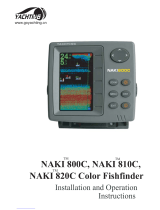
Congratulations on choosing a Navman fish-
finder. For maximum benefit, please read this
manual carefully before installation and use.
This manual describes how to install and set up
the FISH 4500/4600 and the associated dual-
The FISH 4500/4600 is a high quality, dual-
frequency sonar fishfinder that is supplied with
a dual-frequency transducer. It uses TFT (Thin
Film Transistor) technology to provide a color
display for easy daylight viewing that can be
dimmed for night fishing. The bracket mounting
option also allows the fishfinder to be tilted and
swivelled for optimum viewing.
The colors on the sonar displays are customiz-
able, with a choice of four 16 color palettes and
one 8 color palette. The colors represent differ-
ent signal strengths, making the sonar displays
easy to interpret.
The dual frequency capability enables the
FISH 4500/4600 to operate and display:
• At a high frequency of 200 kHz.
• At a low frequency of 50 kHz.
• Both frequencies side-by-side on a split dis-
play.
• Both frequencies combined together into a
single display.
This capability, combined with a variable power
output of up to 600 W RMS, ensures that the
FISH 4500/4600 operates effectively in shallow
and deep water.
The FISH 4500/4600 can detect the bottom to a
depth of 2000 feet (600 metres) depending on
the clarity of the water, the ultrasonic frequency
chosen and the type of transducer used.
The Navman fishfinder can be used to find fish,
to locate features on the bottom such as reefs
or wrecks and to help recognize favourite fishing
spots from the bottom profile.
1-1 Benefits of the FISH 4500/4600
Important
It is vital to the performance of the fishfinder
that the transducer is installed in the best
location. Please follow the installation
instructions very carefully.
This manual also explains how to operate the
FISH 4500/4600 effectively and provides trou-
bleshooting information and performance tips.
The Navman fishfinder can also assist with
navigation by providing depth information to help
identify the depth contours marked on charts.
The FISH 4500/4600 is particularly suited to
work with the TRACKER 5500/5600 - Navman’s
color display GPS chartplotter with worldwide
coverage.
The two instruments can be connected together
using either NavBus or NMEA, so they can
share data.
IMPORTANT NOTE ON USE. While any
fishfinder can be used as an aid to navigation,
accuracy can be limited by many factors, includ-
ing the location of the transducer. It is the user’s
responsibility to ensure the Navman fishfinder is
installed and used correctly.
With the optional fuel kit, the FISH 4500/4600
also becomes a sophisticated and easy-to-use
fuel computer.
All of the Navman 4000 Series fishfinders use
new proprietary SBN-II Technology for sonar
processing to improve Signal enhancement,
Bottom recognition and Noise rejection.
SBN-II Technology uses digital adaptive filter
algorithms to enhance all returned signals. At the
same time, SBN-II Technology uses active noise
control to reject interference, which can often be
mistaken by fishfinders for true returns.
Using SBN-II Technology, the Navman fishfinder
analyses the reflections from each pulse, filters
false returns and displays what is in the water
under the boat. See section 4-1 Interpreting the
display, for more information.
frequency transom transducer. (If a through
hull transducer is used, refer to the Installation
Instructions supplied with that transducer.)
1 Introduction
FISH 4500/4600 Installation and Operation Manual4
NAVMAN




















